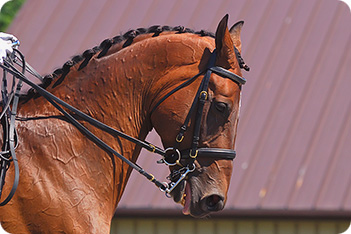

Dressage - Horse Training
Flatwork and lateral work are dressage exercises that the horse undertakes whilst being ridden on the flat as opposed being ridden over jumps. Flatwork covers a multitude of exercises from circles, turns, transitions from pace to pace for example from walk to canter and transitions within a pace such as working trot to medium trot.
Lateral movements are where the horse is asked to move both forwards and sideways at he same time, such as when riding Shoulder In, Travers, Half Pass or Leg Yield.
Leg Yield
This is a Dressage exercise used to supple the horse throughout its entire body. The horse has to move both forwards and sideways at the same time, and remain parallel with the outside track. This is achieved by the horse crossing the front and hind legs over each other during the forwards stride.
It takes time to become proficient at leg yield, the rider needs to be able to give the horse clear aids for leg yield and be able to feel through their seat what the horse is doing underneath them in order to be able to correct the horse if they go unbalanced and feel to what extent the leg yield is progressing to.
More About Leg Yield
Shoulder In
This is a Dressage where the horse moves on three tracks with the shoulders In from the track and with inside bend. Shoulder In is a useful exercise for lightening up a horses forehand as well as helping to supple the horse through their shoulders and engage the hindquarters. It also helps to teach the horse to listen carefully and remain attentive to the riders aids.
More About Shoulder In
Travers
This is a Dressage exercise where the horse is bent around the riders inside leg with the hindquarters at a 30 degree angle inwards. It is also sometimes called Quarters In for this reason. Travers is another excellent movement for helping to engage the hindquarters as well as maintaining forward movement and impulsion.
More About Travers
Extended Trot
During extended trot the horse opens out their frame and increases the length of each stride to the greatest amount possible whilst maintaining balance, cadence and rhythm.
More About Extended Trot
Piaffe
This is a highly collected and elevated trot which the horse appears to be remain on the spot. The horse requires a great amount of engagement in order to perform Piaffe.
More About Piaffe
Half Pass
This is a lateral movement where the horse moves forwards and sideways bent into the direction that it is moving in, it requires a great deal of engagement from the hindquarters and should only be attempted when the horse is already fully established at riding various school movements and lateral work such as Shoulder In, Travers and Leg Yield.
More About Half Pass
Flying Changes
A Flying Change is a change of canter lead that occurs in between canter strides. A series of flying changes are called Tempi Changes and are ridden with four or less canter strides in between each flying change with one time changes being the most challenging as there are no canter strides in between the changes and the horse appears to simply skip from one canter lead to another.
More About Flying Changes
Pirouette
The Full Pirouette is a highly advanced dressage move where the horse with an inside bend, pivots on one of its hind legs and moving its forelegs and other hind leg turns around on the spot to form a circle.
More About The Pirouette
Rein Back
During rein back the horse is asked to take even, straight and deliberate steps backwards, whilst remaining attentive to the riders aids and on the bit.
More About Rein Back
Counter Canter
During Counter Canter the rider deliberately asks the horse to canter on the opposite canter lead to that of the direction that it is moving in. For example the rider picks up left lead canter and whilst maintaining inside bend to the left continues on to ride a circle to the right, whilst maintaining the horses rhythm and balance.
More About Counter Canter
Passage
This is an incredibly elevated trot in which the horse offers a moment of prolonged suspension in between each stride. Passage requires a great amount of engagement from the hindquarters and should only be attempted with horses who are already fully established in collection, lateral work and Piaffe.
More About Passage